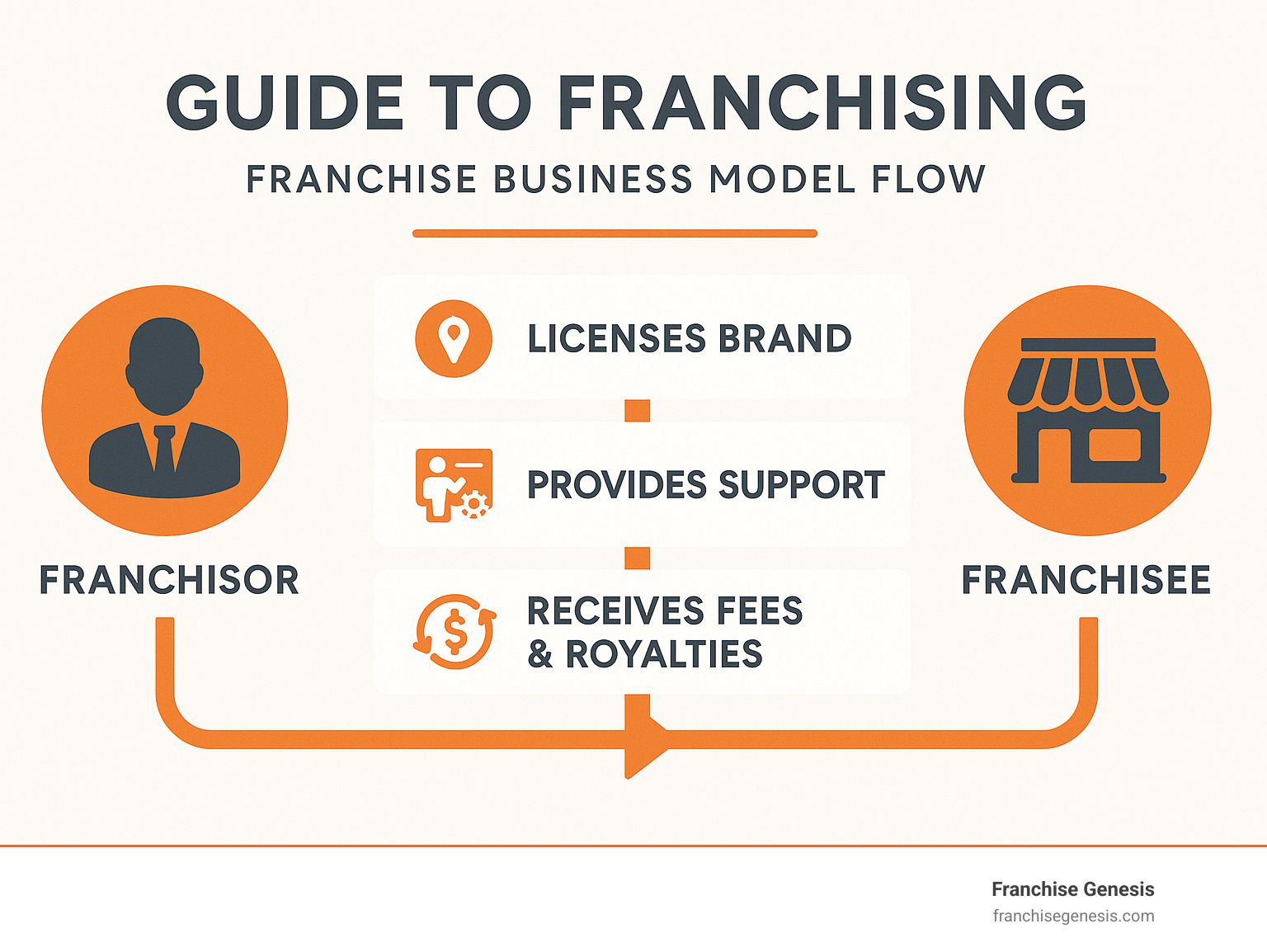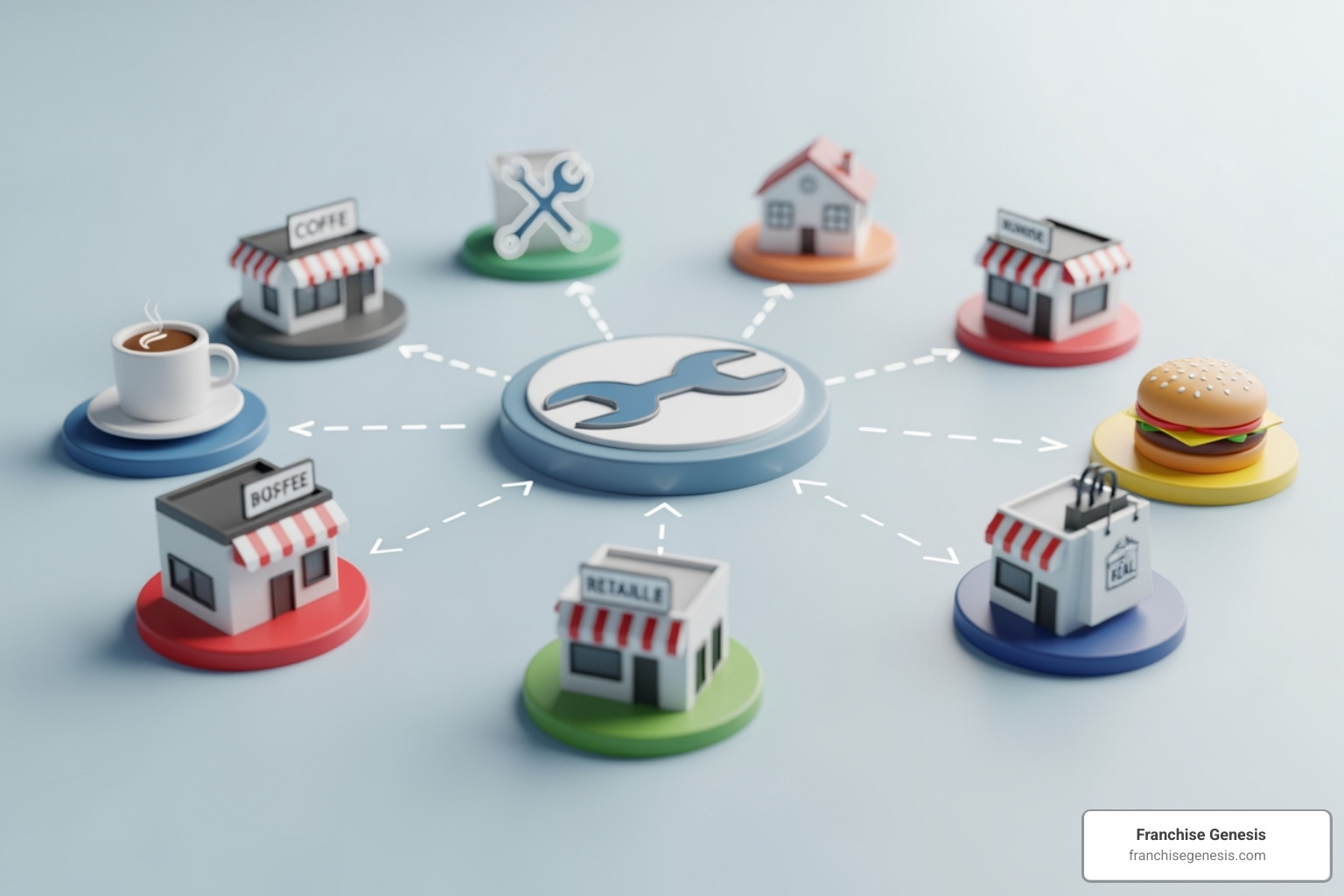From Successful Business to Thriving Franchise
As a successful business owner, you might be looking to expand. A guide to franchising can show you how to grow your brand by replicating your success through others. It’s a powerful way to expand without needing all your own capital for new locations.
Here’s a quick overview of what it means to franchise your business:
- You license your brand: Grant franchisees the right to use your proven business model and trademarks.
- You provide support: Give franchisees training, systems, and ongoing assistance.
- You create new revenue: Earn initial franchise fees and ongoing royalties.
- You expand your reach: Grow your brand quickly by leveraging the investment of individual owners.
With the franchise sector projected to grow by 2.2% in 2024, it’s a strong path for expansion. This guide will walk you through everything you need to know.
Monique Pelle-Kunkle, Vice President of Operations at Franchise Genesis, guides business owners through the entire guide to franchising process, from identifying expansion potential to structuring and growing their franchise models.

Is Your Business Ready for Franchising?

If you’ve built a successful business, you might wonder if it’s ready to become a franchise. Before expanding, it’s crucial to honestly assess if your business has what it takes.
Franchising isn’t just about profitability; it’s about having a replicable, scalable system that others can successfully operate. The core of franchise readiness is whether someone else can follow your documented process and achieve the same results.
To be franchise-ready, your business needs several key criteria: proven profitability at the unit level, showing a clear ROI for franchisees; scalable systems that don’t depend on your personal presence; strong brand strength with customer recognition and trust; and genuine market demand beyond your current location.
| Feature | Franchising Your Business | Corporate Expansion |
|---|---|---|
| Capital | Primarily franchisee-funded; lower capital strain on franchisor | High capital investment required from parent company |
| Speed | Rapid expansion possible due to multiple simultaneous openings | Slower, limited by internal capital and management resources |
| Control | Less direct day-to-day control over individual units | Full control over all operational aspects |
| Support | Extensive training and ongoing support for franchisees required | Internal management and operational support for employees |
If you’re still nodding along, you might want to dive deeper into Why You Should Franchise to explore the full picture.
Assessing Your Business Model
A successful franchise starts with a solid business model assessment. Your guide to franchising journey begins by asking tough questions about your concept’s readiness.
Your business must be a replicable concept that doesn’t rely on your personal charm or unique skills. If customers come for you and not your system, franchising isn’t yet viable.
Strong unit economics are non-negotiable. Each location must be consistently profitable, as future franchisees will scrutinize these numbers. They need proof that your system leads to financial success.
All procedures must be captured in documented processes. From opening to marketing, if it’s not documented, it can’t be replicated. This documentation becomes the backbone of your operations manual, ensuring consistent quality.
Achieving reduced owner dependency is often the biggest challenge. If the business can’t run without you daily, it’s not ready. You must transition from a hands-on operator to a leader who trains and supports others.
Evaluating the Pros and Cons
Franchising offers incredible opportunities, but it’s important to be realistic about the pros and cons.
The advantages are compelling. Rapid expansion is possible using franchisee capital. You gain motivated partners with skin in the game; franchised stores often outperform company-owned locations by 15-25% because owners are more invested than managers.
Your brand recognition grows with each new location. You also build new revenue streams through initial franchise fees and ongoing royalties (typically 4-12% of gross sales), creating predictable income for further growth.
However, franchising has trade-offs. You lose some direct control over daily operations, which can be difficult for hands-on owners. You also take on significant support obligations, as franchisees require ongoing training, marketing, and operational guidance. It’s not a passive strategy.
The legal complexity is significant. Franchising is heavily regulated, requiring detailed disclosure documents and legal compliance to avoid hefty fines. You must also accept that franchisees keep most profits while you earn fees and royalties; that’s the trade-off for them taking the risk.
Finally, there’s reputational risk. A single underperforming franchisee can damage your entire brand. You are trusting others with the standards you’ve worked hard to build.
Franchising transforms you from an operator into a system provider, a fundamental shift requiring a new mindset. For the right business and owner, it’s a rewarding path to growth and legacy building.
The Legal and Financial Blueprint for Franchising
Once you’ve decided to franchise, the next step is building a strong legal and financial foundation. This is the bedrock for your future success and is an essential part of this guide to franchising.
This stage protects your brand and ensures franchisees have a clear path to success. While it involves significant paperwork, it’s essential. For expert help, explore our Services for Franchisors and Franchisees.
The Franchise Disclosure Document (FDD) Explained
The Franchise Disclosure Document (FDD) is the heart of legal franchising in the U.S. Required by the Federal Trade Commission (FTC), this critical legal document provides potential franchisees with all the necessary information about your franchise opportunity.
The FDD contains 23 specific items covering everything from company history and legal issues to a full cost breakdown. It details the obligations of both the franchisor and franchisee and includes a sample franchise agreement.
Creating an FDD is a legal requirement. You must complete and register your FDD before selling any franchises. Some states have additional registration steps, adding time and complexity.
The purpose of the FDD is transparency. Providing detailed information upfront builds trust and helps attract the right candidates for your brand.
Due to its complexity, working with an experienced franchise lawyer is crucial. They ensure your FDD complies with all federal and state regulations, helping you avoid significant legal issues. A good lawyer can prepare your FDD for multiple states, preventing future complications.
To learn even more about this vital document, you can Learn more about the FDD from the Federal Trade Commission.
Understanding the Costs: A Financial Guide to Franchising
Franchising your business has upfront costs, but the investment is typically much lower than opening new corporate locations. You are investing in the framework that allows others to fund expansion under your brand.
The initial cost to franchise your business generally ranges from $18,500 to $84,500, though it can exceed $100,000 for more complex models. The final cost depends on your specific needs.
A significant portion of the cost goes to legal fees for an experienced franchise lawyer to draft your FDD and franchise agreement. These fees vary with business complexity.
Budgeting for your operations manual is also necessary. This comprehensive guide, costing between $15,000 and $20,000, is crucial for brand consistency.
Trademark registration with the USPTO is a must to protect your brand assets for franchisee use. You may also want to establish a separate franchise entity (e.g., an LLC) to protect your original business and simplify financial reporting.
Finally, you’ll need funds for marketing setup and a sales strategy, including materials and a franchise sales website. The entire process to become legally ready to sell franchises typically takes 90 to 120 days.
While these initial costs might seem like a lot, they’re a one-time investment that open ups massive growth potential. It’s an investment in your brand’s future, allowing you to scale using other people’s capital. For more details on any state-specific requirements that might affect your costs, take a look at our Franchise Registration States Guide.
Crafting the Franchise Agreement
After the FDD, the next step is the franchise agreement. This legal contract defines the relationship between you (the franchisor) and the franchisee. It outlines all roles and responsibilities and is key to the long-term health of your franchise system.
Here are some of the main things you’ll find detailed in a good franchise agreement:
It states the term length (typically 5-10 years) and outlines all fees and royalties, including the initial franchise fee, ongoing royalties (a percentage of sales), and any marketing fund contributions.
The agreement defines territory rights, specifying if a franchisee has an exclusive operational area. It also details your training and support obligations, including initial training and ongoing assistance.
Crucially, the agreement establishes the operating standards a franchisee must follow to ensure quality and brand consistency across all locations, reinforcing the importance of your operations manual.
Finally, it covers clauses for renewal, termination, and transfer, explaining how the agreement can be renewed, the grounds for termination, and the process for a franchisee to sell their business. The agreement also reinforces the franchisee’s right to use your intellectual property.
The franchise agreement is a serious document designed to protect both parties and serves as the foundation for a strong partnership.
Your Complete Guide to Franchising Systems and Support
With the legal and financial details sorted, it’s time to build the systems that help your franchisees thrive. You’re not just selling a business; you’re selling a proven system and a promise of support. This fulfills the promise that franchisees are “in business for themselves, but not by themselves.”
A strong support system is key to franchisee success, which reflects directly on your brand and the health of your network. Learn more by Understanding the Key to Building a Thriving Franchise Network.
Creating Your Franchise Operations Manual
Your operations manual is the backbone of your franchise system. It’s the practical, “how-to” blueprint for daily success, complementing the legal FDD.
This manual is the “how-to” guide for every aspect of the business, from daily operations and customer service to inventory and local marketing. It’s the complete playbook for your franchisees.
The manual is vital for standardizing procedures, ensuring every unit operates identically. This maintains high quality and brand consistency, so customers receive the same great experience everywhere.
It’s crucial for ensuring brand consistency, dictating everything from store appearance to customer interactions to protect your brand’s reputation. As it contains trade secrets, it is a confidential document shared only with franchisees and authorized staff.
A well-crafted operations manual reduces training time, serves as a quick reference, and ensures brand standards are met. Learn more about creating this essential tool in our guide to franchising with insights on the Franchise Operations Manual.
Developing a World-Class Training Program
Excellent franchisee training is critical. It’s how you transfer your knowledge and experience, setting them up for success from day one.
Your initial training is a comprehensive pre-opening program covering operations, sales, marketing, and customer service. It can include classroom learning, hands-on practice, and online courses.
Many franchisors also provide on-site support during the grand opening and initial weeks. This hands-on help is invaluable for problem-solving and reinforcing training.
Ongoing education is a must to adapt to a changing business world. Offer continuous learning via webinars, workshops, conventions, and popular online learning modules to maintain quality and prevent bad habits.
Finally, measure success by gathering feedback and reviewing performance data to see if franchisees are understanding and applying the training. This allows you to improve your program and shows your commitment to their success, strengthening the partnership.
Establishing Marketing and Brand Standards
A key benefit for franchisees is your established brand and marketing support. You provide the tools and rules to leverage the brand power you’ve already built.
Clear brand guidelines are essential. They dictate the use of your logo, colors, and brand voice to ensure a consistent and professional look across all locations.
While you manage national marketing campaigns for brand awareness, franchisees must conduct local marketing. Provide them with templates, approved ads, and strategic advice to help them connect with their local community.
Many franchisors create a national advertising fund by collecting a small marketing fee from franchisees. As the franchisor, you manage this fund for the benefit of the entire system; transparency in its use is crucial for trust.
Simplify marketing for franchisees by supplying marketing materials. Provide access to photos, videos, social media content, and print templates to help them promote their locations effectively.
A unified marketing effort benefits everyone by increasing brand visibility and driving customers to all locations. This teamwork is key to a thriving network. To learn more, check out our insights on Franchise Sales & Marketing.
Launching and Growing Your Franchise Network

With a solid foundation in place, it’s time for the exhilarating part: launching and growing your franchise network. This phase is about strategically setting growth goals and pacing expansion to build a thriving ecosystem.
The franchising industry offers significant opportunities, with sectors like health, personal care & fitness (projected 3.0% growth in 2024) and Quick Service Restaurants (QSRs) leading the way. As you expand, you’re not just growing a business; you’re building a legacy. Connect with peers through resources like the International Franchise Association community.
The Franchisee Recruitment Process: A Sales Guide to Franchising
Recruiting franchisees is less a hard sell and more about finding partners who share your vision and drive. It’s a sales process built on trust and a shared entrepreneurial spirit.
First, define your ideal franchisee profile. Consider the background, skills, financial capacity, and personality traits needed to succeed. This helps you target the right candidates.
Next is lead generation. You can find candidates through franchise expos, online portals, and smart digital marketing. Don’t overlook referral programs from those who know your brand. You can also partner with franchise consultants or brokers to connect with pre-qualified candidates.
A pivotal step is the Findy Day, where you invite prospects to your headquarters. This allows them to experience your culture and operations, while you assess if they are a good fit. It’s a mutual evaluation to ensure a strong partnership.
After due diligence, you award the franchise by signing the franchise agreement. This guide to franchising emphasizes relationship building over just closing deals. For more strategies, Transform Leads into Loyal Franchisees with a Proven Sales Strategy.
Supporting Your First Franchisees for Long-Term Success
Your first franchisees are your pioneers and brand ambassadors. Their success is vital, as it validates your system and attracts more candidates to your network.
Provide excellent grand opening support. This hands-on assistance ensures a smooth launch and shows your investment in their success from day one.
Regular communication is key. Establish clear channels like check-ins, newsletters, and an online portal for resources and support.
Use performance monitoring to help franchisees track their numbers. Offer constructive feedback and identify areas for additional coaching. Their growth is your growth.
Building a strong franchisee community is highly rewarding. Foster connections and peer support through meetings, forums, and conventions. A sense of community helps franchisees thrive.
Finally, pace your growth, especially early on. Ensure your support infrastructure can handle the demands of a growing network. Nurturing your first franchisees lays the groundwork for a robust and enduring system.
Conclusion: Begin Your Journey to Becoming a Franchisor
This guide to franchising has covered the complete journey: assessing your business’s readiness, navigating legal and financial requirements, building support systems, and planning for growth.
Franchising is more than an expansion strategy; it’s a partnership. You provide a proven blueprint, brand recognition, and support. Your franchisees bring local market knowledge, capital, and entrepreneurial passion.
This symbiotic relationship is powerful. It’s about multiplying your impact, creating opportunities for others, and building something beyond what you could achieve alone.
Franchising is ultimately about building a legacy. You’re changing a single business into a network that creates jobs, serves customers, and empowers other entrepreneurs with your perfected system.
The path to becoming a franchisor has challenges: legal complexities, a required mindset shift from operator to supporter, and the weighty responsibility for others’ success. However, for those who are ready, the financial and personal rewards are extraordinary.
At Franchise Genesis, we’ve guided countless business owners through this transition. We understand the process and are here to help you every step of the way, from initial assessment to launching your franchisees.
We believe in building partnerships. When you and your franchisees succeed, we all win.
Ready to take the next step and find how your successful business could become a thriving franchise network? We’d love to help you explore the possibilities. Learn how to Franchise Your Business with the team that truly understands this journey.
Your legacy is waiting. Let’s build it together.


